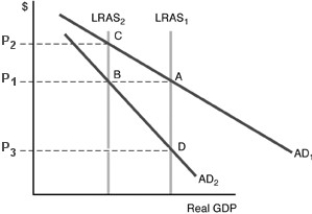Multiple Choice

-Refer to the above figure. Suppose the economy's initial equilibrium is represented by the intersection of LRAS₁ and AD₁. Suppose there is a persistent reduction in labor force participation, which reduces total planned production at any given price level. The resulting change in the economy's long-run equilibrium position would be represented by a
A) movement from A to C.
B) movement from A to B.
C) movement from B to C.
D) movement from C to A.
Correct Answer:

Verified
Correct Answer:
Verified
Q8: All of the following would cause the
Q17: What is one implication of the real-balance
Q70: Which of the following would likely result
Q106: If a nation's production possibilities curve shifts
Q141: Long-run aggregate supply reflects<br>A) total production in
Q213: When the aggregate demand curve shifts _
Q224: <img src="https://d2lvgg3v3hfg70.cloudfront.net/TB5018/.jpg" alt=" -In the above
Q234: An increase in the amount of physical
Q239: The total of all planned real expenditures
Q294: How does aggregate demand curve (AD) differ